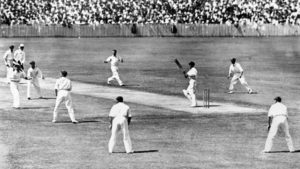
For the vast majority of people, the very mention of Brazil conjures up images of football, from Pelé leaping to head goalwards in the 1970 World Cup or beach soccer on the sun-kissed sands of Rio. However, few realise that before the arrival of football, another sport was already gaining hold in Brazil, brought by travellers from the UK and inspiring ordinary Brazilians to play on the streets: cricket. It’s true that nowadays, not many Brazilians could explain how cricket itself is played. However, the basics (bats, balls, bowlers, batters running between the wickets) are easily understandable to anyone who has played the traditional street game of ‘taco’. And although cricket may have spent a number of years lying dormant, recent years have seen a renaissance of the game in Brazil.
The story of cricket in Brazil begins in the mid-19th century. At the time, Great Britain was the world’s only superpower and there was significant trade between the 2 countries in coffee, sugar and cotton. Furthermore, British engineers were commonplace in Brazil, drawn here by infrastructure projects such as those to create the railway system. It was also a time when cricket was booming in Victorian England and in WG Grace, cricket had the world’s first international sporting superstar. Amateur cricket enthusiasts among the foreign contingent here played the first matches in Brazil, and there is a reference to cricket being played in the São Cristovão area of Rio in 1836. It is thought that some locals, inspired by watching this strange new pastime, began to play their own simplified version (the aforementioned taco) which would go on to become a common sight on suburban streets in Brazil around a century later.
Cricket itself started to become more organised with the foundation on 15th August 1872 of Rio Cricket Club. Originally games were played in Botafogo, but in 1897 founders Basil Freeland and George Emmanuel Cox relocated the club to the city of Niteroi on the other side of Guanabara Bay, taking the new name of Rio Cricket e Associação Atlética (RC&AA). By this time there was a rival team in Rio: in 1875, following a disagreement between members of the original Rio Cricket Club, a breakaway club had been founded. It become known as Paysandu Cricket Club in 1880, the name coming from the famous street in Flamengo where it rented some land to hold games. In 1898, the clubs contested the first edition of what would become an annual competition, the Rio-Nictheroy cricket championship. In fact both RC&AA and Paysandu Cricket Club did not limit their activities to cricket. It was Paysandu club member Oscar Alfredo Cox (son of George) who brought the first football to Rio in 1896, and the clubs would face each other at cricket, football, bowls and tennis in a series of contests that became known as the Clássico dos Ingleses (‘the English Derby’). Oscar also founded one of Rio’s most prestigious football teams, Fluminense, in 1902. Both clubs took part in the first few editions of the Carioca Championship, a football tournament open to teams in Rio, between 1908 and 1915. However, this participation was suspended as club members returned to Europe to fight in the First World War.
Rio was not the only city in Brazil with a nascent cricketing culture. São Paulo Cricket Club was founded in 1874 and became known as São Paulo Athletic Club (SPAC) in 1888. It had among its members one Charles Miller, the man known as the father of football in Brazil. The first recorded cricket match between Rio and São Paulo happened in 1875. A Bahia Cricket Club existed in Salvador in the 1870s, and subsequently International Cricket Club and Victoria Cricket Club (VCC) were founded in Bahia in 1899. During the interwar years, there was sufficient cricketing activity for Brazil to raise a representative side that would regularly sail to Argentina and vice-versa to engage in ‘Test’ matches. Just like their counterparts in Rio, the clubs around Brazil engaged in a wide range of different sports including football, and perhaps this is one reason for the failure of cricket to take deeper root in Brazil in the longer term. As football exploded in popularity, cricket gradually slipped from view, although it didn’t disappear entirely. Cricket continued to be played at RC&AA after WWII up until the early 2000s, and similarly in São Paulo. Nevertheless, these days VCC (now called Esporte Club Victoria) and SPAC are both primarily known as football clubs competing in the lower tiers of Brazilian football.
It wasn’t until the beginning of the 21st century that cricket started to undergo a rebirth, again driven by cricket fans from all around the world who live and work here and whose energy and enthusiasm has seen a number of different projects emerge. There are currently cricket teams in Rio, São Paulo, Brasília, Belo Horizonte and Poços de Caldas in Minas Gerais that compete in the annual National Cricket Championship. The Brazilian Cricket Confederation was founded in 2001 and became an affiliate member of the ICC in 2003. The Brazilian women’s team won the South American Twenty20 championship in 2015, 2016, 2018 e 2019 and has ambitious plans for the future. Carioca Cricket Club itself was founded in 2011 and since then has driven the revival of cricket in Rio, attracting foreigners and Brazilians alike to practise in the shadow of the iconic statute of Christ the Redeemer and play games in the nearby city of Itaguaí. So there is now an expanding group of people in Brazil whose treasured sporting memories here are not of football but of the wonderful game of cricket.
